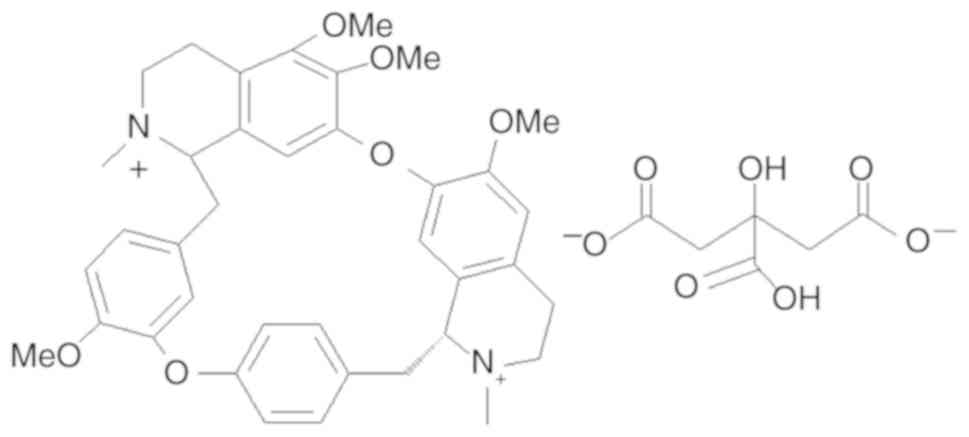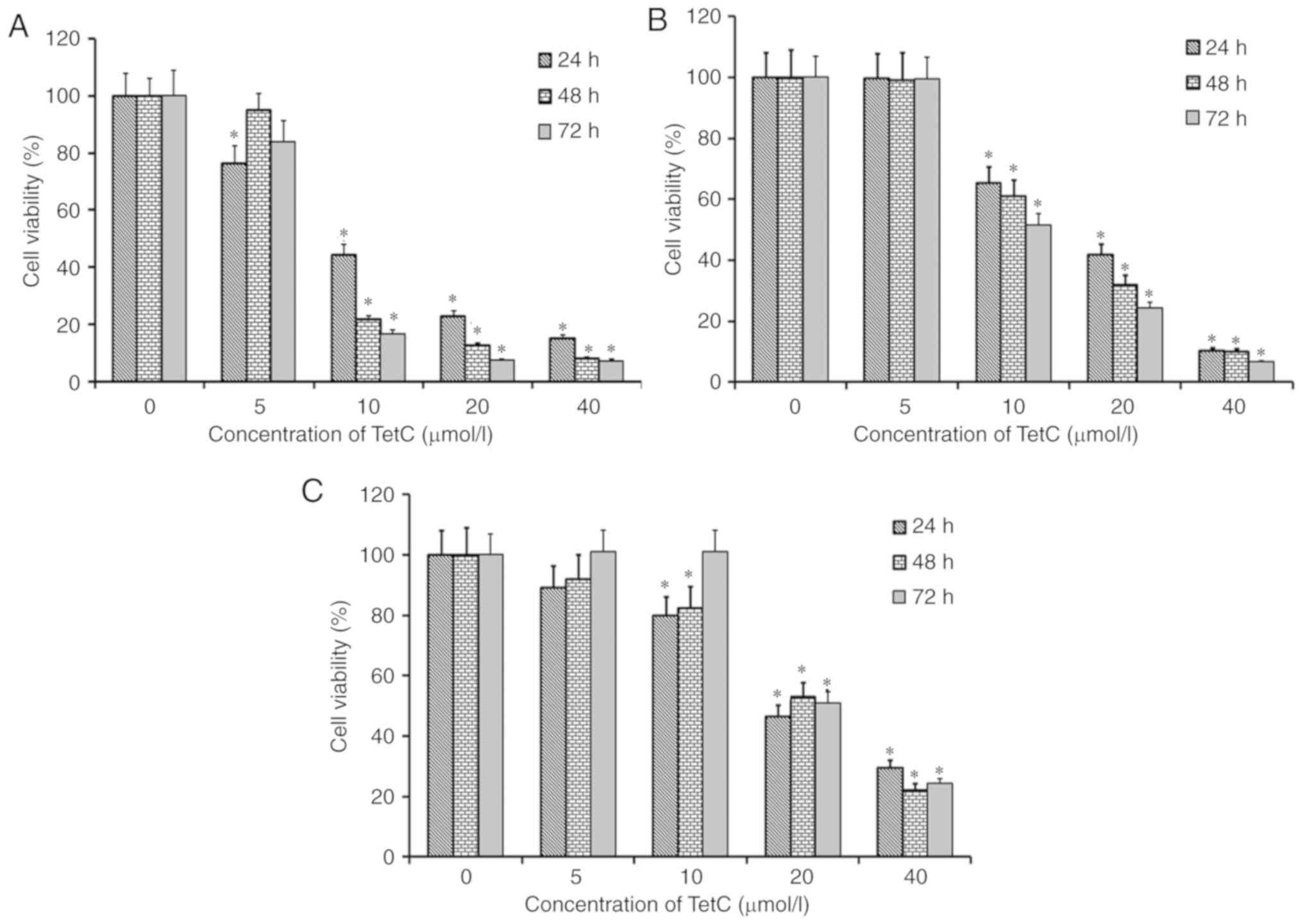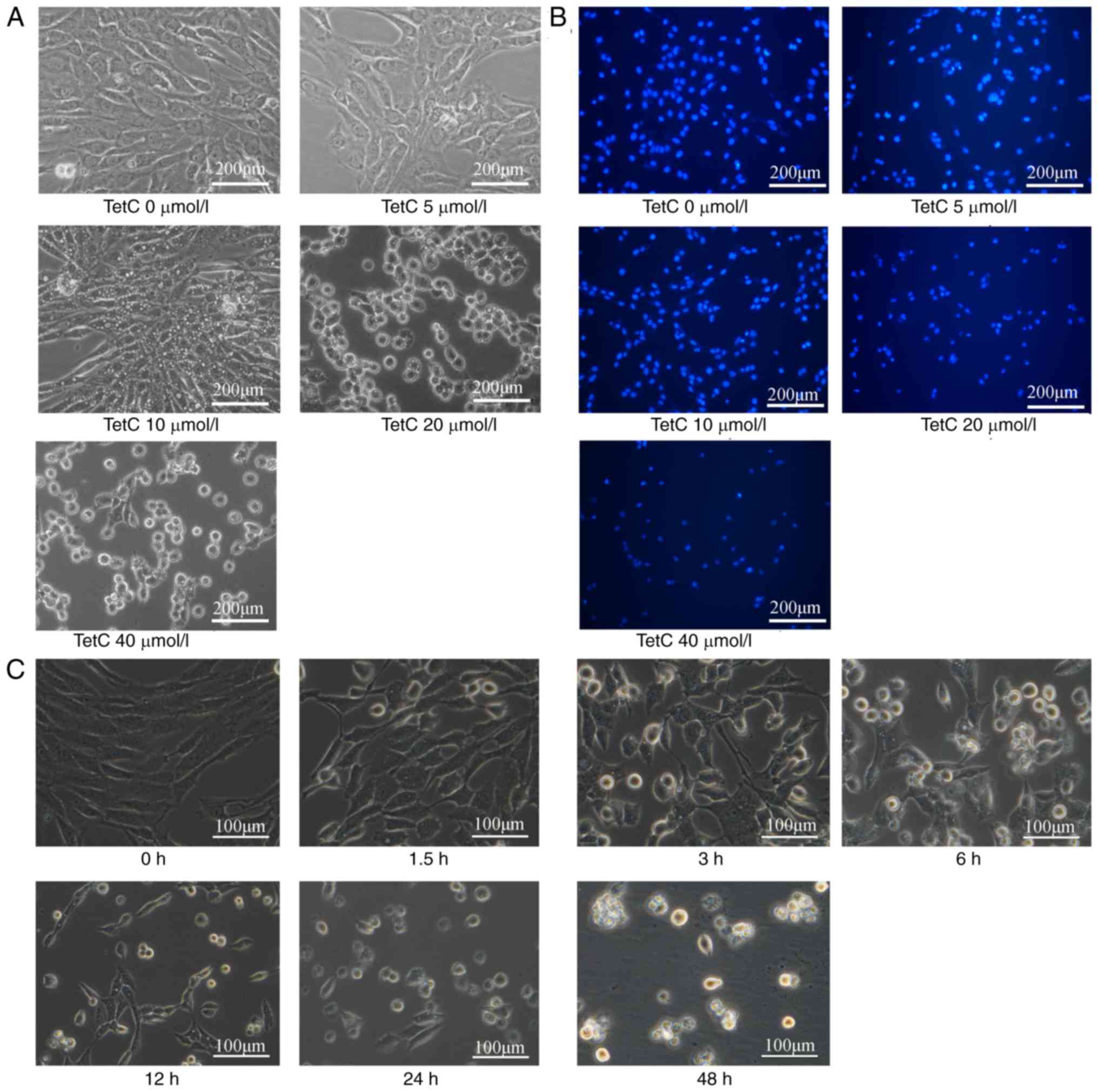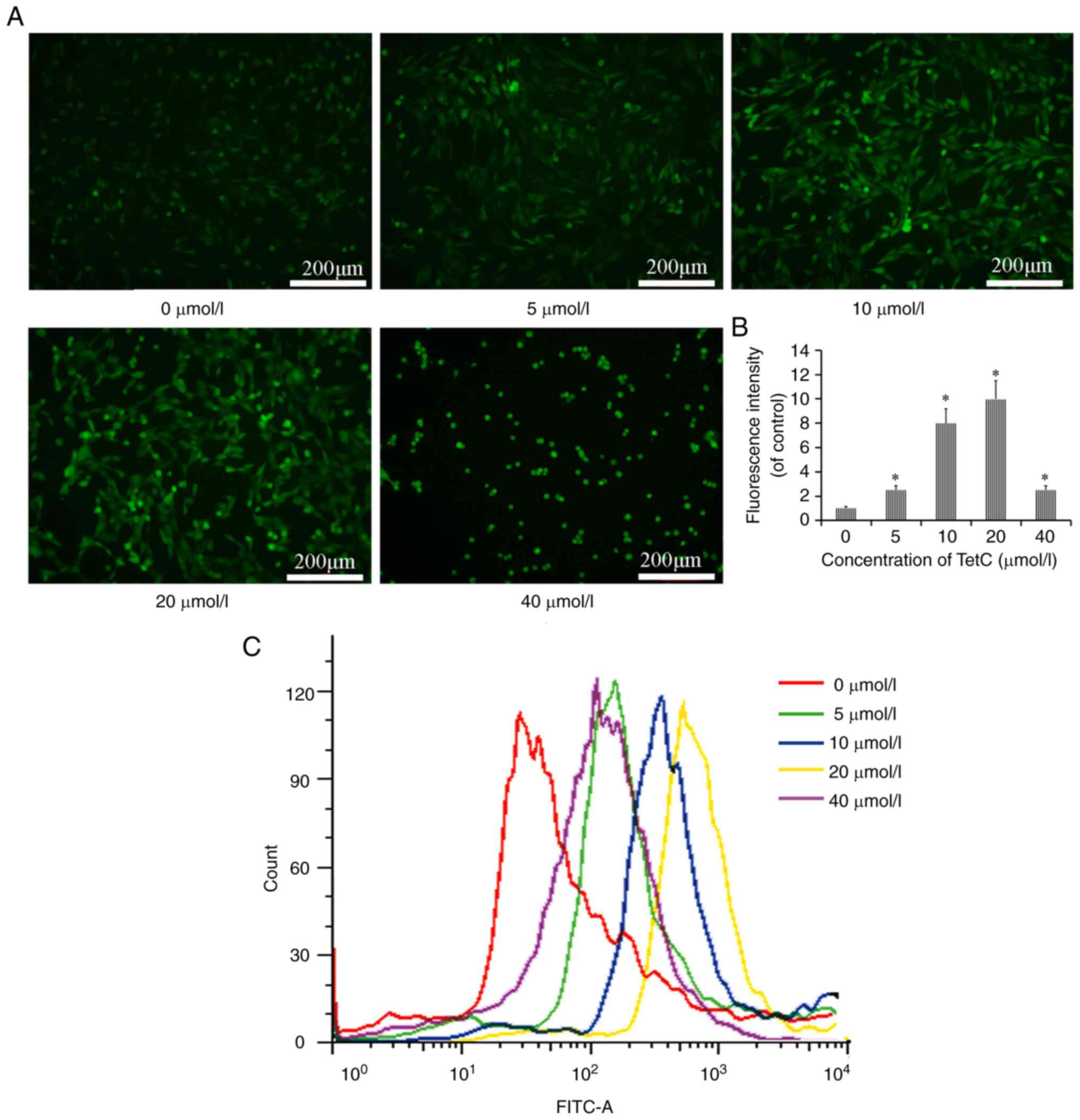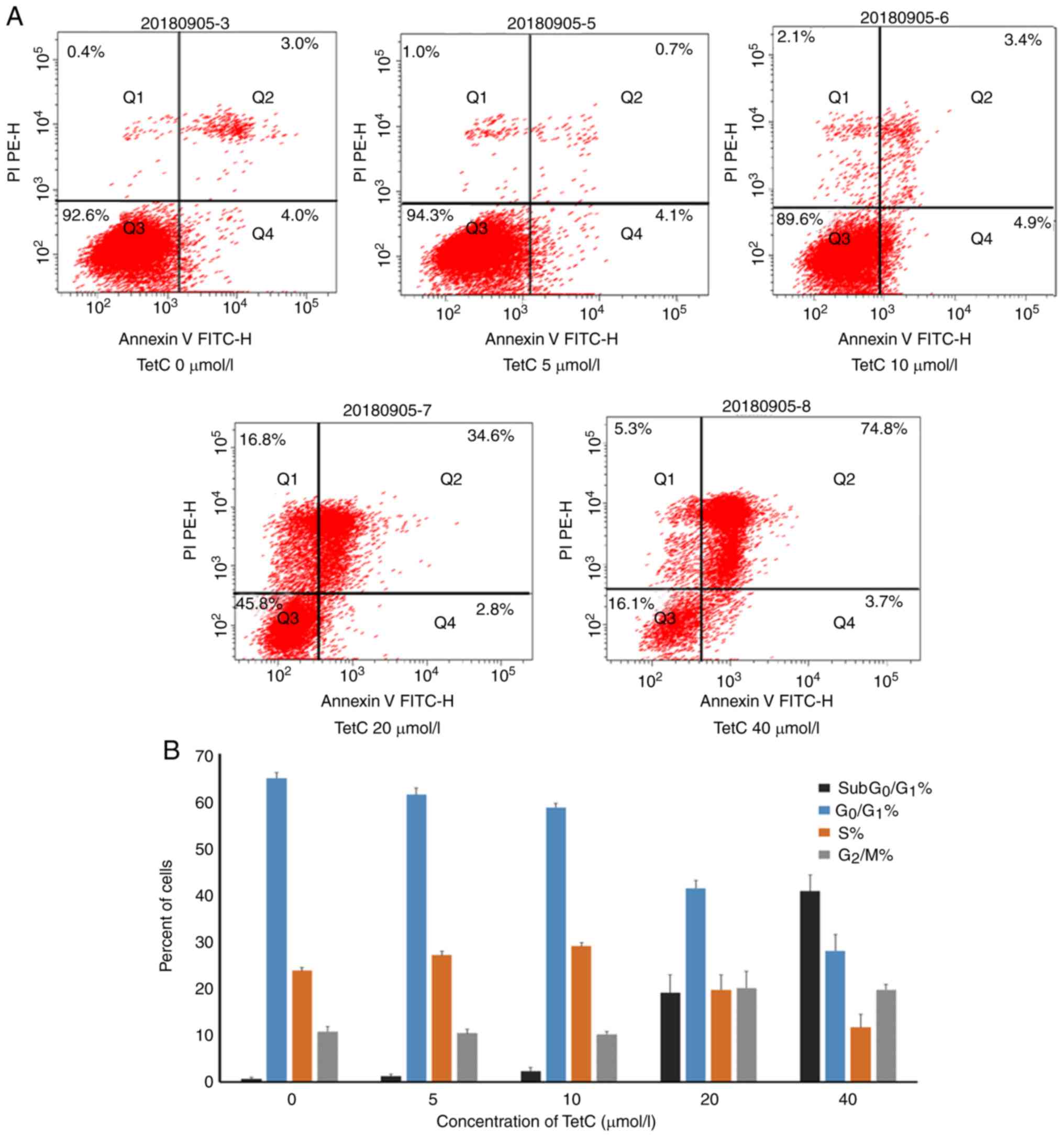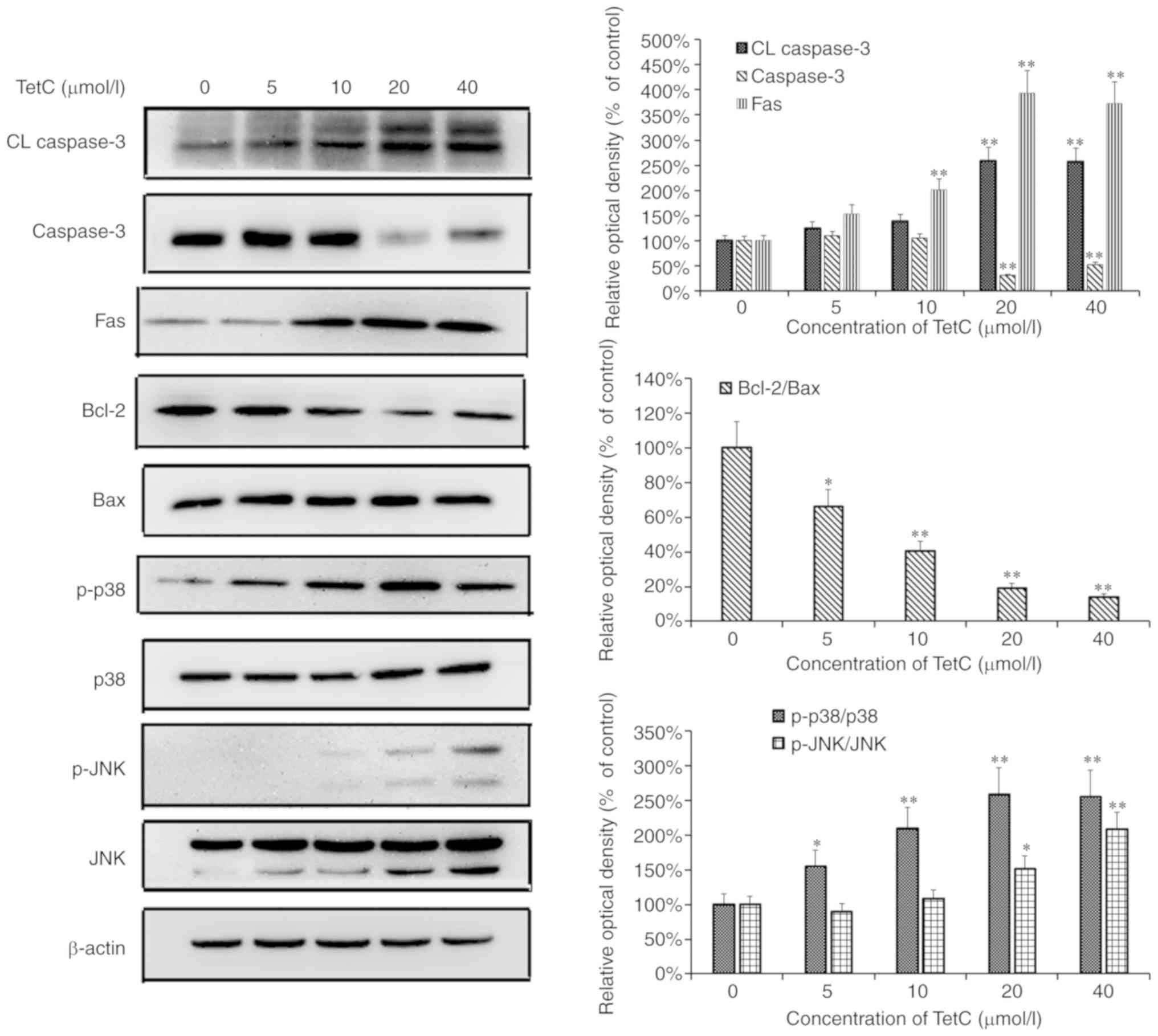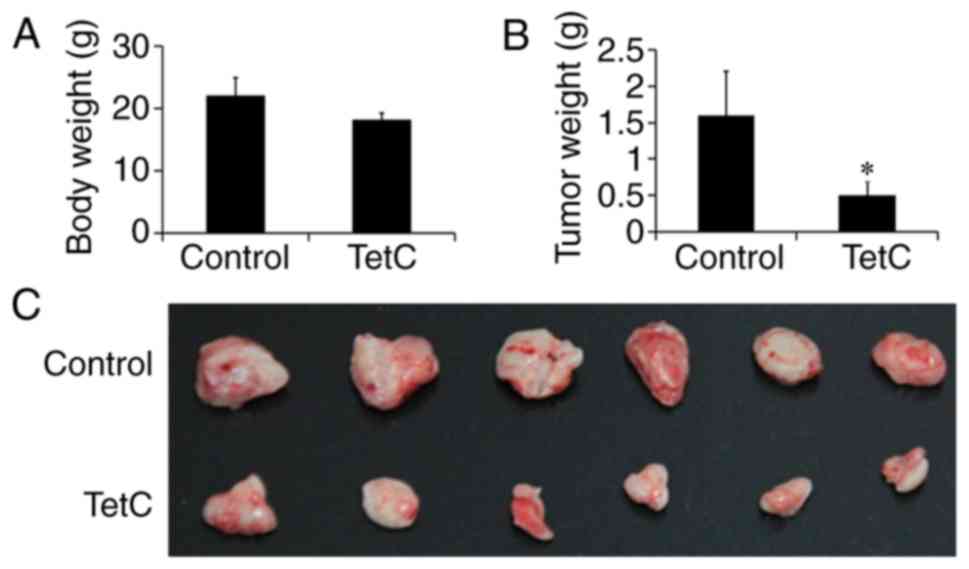|
1
|
Friedman HS, Kerby T and Calvert H:
Temozolomide and treatment of malignant glioma. Clin Cancer Res.
6:2585–2597. 2000.PubMed/NCBI
|
|
2
|
Gao J, Wang Z, Liu H, Wang L and Huang G:
Liposome encapsulated of temozolomide for the treatment of glioma
tumor: Preparation, characterization and evaluation. Drug Discov
Ther. 9:205–212. 2015. View Article : Google Scholar : PubMed/NCBI
|
|
3
|
Kawaji H, Tokuyama T, Yamasaki T, Amano S,
Sakai N and Namba H: Interferon-beta and temozolomide combination
therapy for temozolomide monotherapy-refractory malignant gliomas.
Mol Clin Oncol. 3:909–913. 2015. View Article : Google Scholar : PubMed/NCBI
|
|
4
|
Yu Z, Xie G, Zhou G, Cheng Y, Zhang G, Yao
G, Chen Y, Li Y and Zhao G: NVP-BEZ235, a novel dual PI3K-mTOR
inhibitor displays anti-glioma activity and reduces chemoresistance
to temozolomide in human glioma cells. Cancer Lett. 367:58–68.
2015. View Article : Google Scholar : PubMed/NCBI
|
|
5
|
Wang X, Jia L, Jin X, Liu Q, Cao W, Gao X,
Yang M and Sun B: NF-κB inhibitor reverses temozolomide resistance
in human glioma TR/U251 cells. Oncol Lett. 9:2586–2590. 2015.
View Article : Google Scholar : PubMed/NCBI
|
|
6
|
Tian T, Li A, Lu H, Luo R, Zhang M and Li
Z: TAZ promotes temozolomide resistance by upregulating MCL-1 in
human glioma cells. Biochem Biophys Res Commun. 463:638–643. 2015.
View Article : Google Scholar : PubMed/NCBI
|
|
7
|
Dunn-Pirio AM and Vlahovic G:
Immunotherapy approaches in the treatment of malignant brain
tumors. Cancer. 123:734–750. 2017. View Article : Google Scholar : PubMed/NCBI
|
|
8
|
Wu Z, Wang G, Xu S, Li Y, Tian Y, Niu H,
Yuan F, Zhou F, Hao Z, Zheng Y, et al: Effects of tetrandrine on
glioma cell malignant phenotype via inhibition of ADAM17. Tumour
Biol. 35:2205–2210. 2014. View Article : Google Scholar : PubMed/NCBI
|
|
9
|
Li X, Wu Z, He B and Zhong W: Tetrandrine
alleviates symptoms of rheumatoid arthritis in rats by regulating
the expression of cyclooxygenase-2 and inflammatory factors. Exp
Ther Med. 16:2670–2676. 2018.PubMed/NCBI
|
|
10
|
Gao LN, Feng QS, Zhang XF, Wang QS and Cui
YL: Tetrandrine suppresses articular inflammatory response by
inhibiting pro-inflammatory factors via NF-κB inactivation. J
Orthop Res. 34:1557–1568. 2016. View Article : Google Scholar : PubMed/NCBI
|
|
11
|
Lai JH: Immunomodulatory effects and
mechanisms of plant alkaloid tetrandrine in autoimmune diseases.
Acta Pharmacol Sin. 23:1093–1101. 2002.PubMed/NCBI
|
|
12
|
Miao RM, Fang ZH and Yao Y: Therapeutic
efficacy of tetrandrine tablets combined with matrine injection in
treatment of silicosis. Zhonghua Lao Dong Wei Sheng Zhi Ye Bing Za
Zhi. 30:778–780. 2012.(In Chinese). PubMed/NCBI
|
|
13
|
Zhang HN, Xin HT, Zhang WD, Jin CJ, Huang
SY and Zhang Y: The anti-fibrotic effects of Qidan granule in
experimental silicosis. Zhonghua Yu Fang Yi Xue Za Zhi. 41:290–294.
2007.(In Chinese). PubMed/NCBI
|
|
14
|
Miao RM, Sun XF, Zhang YY, Wu W, Fang ZH,
Zhao R, Zhao DK, Qian GL and Ji J: Clinical efficacy of tetrandrine
combined with acetylcysteine effervescent tablets in treatment of
silicosis. Zhonghua Lao Dong Wei Sheng Zhi Ye Bing Za Zhi.
31:857–858. 2013.(In Chinese). PubMed/NCBI
|
|
15
|
Zhang TJ, Guo RX, Li X, Wang YW and Li YJ:
Tetrandrine cardioprotection in ischemia-reperfusion (I/R) injury
via JAK3/STAT3/Hexokinase II. Eur J Pharmacol. 813:153–160. 2017.
View Article : Google Scholar : PubMed/NCBI
|
|
16
|
Huang P, Xu Y, Wei R, Li H, Tang Y, Liu J,
Zhang SS and Zhang C: Efficacy of tetrandrine on lowering
intraocular pressure in animal model with ocular hypertension. J
Glaucoma. 20:183–188. 2011. View Article : Google Scholar : PubMed/NCBI
|
|
17
|
Zhang J, Yu B, Zhang XQ, Sheng ZF, Li SJ,
Wang ZJ, Cui XY, Cui SY and Zhang YH: Tetrandrine, an
antihypertensive alkaloid, improves the sleep state of
spontaneously hypertensive rats (SHRs). J Ethnopharmacol.
151:729–732. 2014. View Article : Google Scholar : PubMed/NCBI
|
|
18
|
Yuan B, Yao M, Wang X, Sato A, Okazaki A,
Komuro H, Hayashi H, Toyoda H, Pei X, Hu X, et al: Antitumor
activity of arsenite in combination with tetrandrine against human
breast cancer cell line MDA-MB-231 in vitro and in vivo. Cancer
Cell Int. 18:1132018. View Article : Google Scholar : PubMed/NCBI
|
|
19
|
N B and K RC: Tetrandrine and cancer-an
overview on the molecular approach. Biomed Pharmacother.
97:624–632. 2018. View Article : Google Scholar : PubMed/NCBI
|
|
20
|
Wong V, Zeng W, Chen J, Yao XJ, Leung ELH,
Wang QQ, Chiu P, Ko BCB and Law BYK: Tetrandrine, an activator of
autophagy, induces autophagic cell death via PKC-α inhibition and
mTOR-dependent mechanisms. Front Pharmacol. 8:3512017. View Article : Google Scholar : PubMed/NCBI
|
|
21
|
Liu T, Liu X and Li W: Tetrandrine, a
Chinese plant-derived alkaloid, is a potential candidate for cancer
chemotherapy. Oncotarget. 7:40800–40815. 2016.PubMed/NCBI
|
|
22
|
Joshi P, Vishwakarma RA and Bharate SB:
Natural alkaloids as P-gp inhibitors for multidrug resistance
reversal in cancer. Eur J Med Chem. 138:273–292. 2017. View Article : Google Scholar : PubMed/NCBI
|
|
23
|
Fu L, Liang Y, Deng L, Ding Y, Chen L, Ye
Y, Yang X and Pan Q: Characterization of tetrandrine, a potent
inhibitor of P-glycoprotein-mediated multidrug resistance. Cancer
Chemother Pharmacol. 53:349–356. 2004. View Article : Google Scholar : PubMed/NCBI
|
|
24
|
Jin L, Xu M, Luo XH and Zhu XF: Stephania
tetrandra and ginseng-containing chinese herbal formulation NSENL
reverses cisplatin resistance in lung cancer xenografts. Am J Chin
Med. 45:385–401. 2017. View Article : Google Scholar : PubMed/NCBI
|
|
25
|
Chen Y and Tseng SH: The potential of
tetrandrine against gliomas. Anticancer Agents Med Chem.
10:534–542. 2010. View Article : Google Scholar : PubMed/NCBI
|
|
26
|
Chen Y, Chen JC and Tseng SH: Tetrandrine
suppresses tumor growth and angiogenesis of gliomas in rats. Int J
Cancer. 124:2260–2269. 2009. View Article : Google Scholar : PubMed/NCBI
|
|
27
|
Chang KH, Chen ML, Chen HC, Huang YW, Wu
TY and Chen YJ: Enhancement of radiosensitivity in human
glioblastoma U138MG cells by tetrandrine. Neoplasma. 46:196–200.
1999.PubMed/NCBI
|
|
28
|
Imoto K, Takemura H, Kwan CY, Sakano S,
Kaneko M and Ohshika H: Inhibitory effects of tetrandrine and
hernandezine on Ca2+ mobilization in rat glioma C6 cells. Res
Commun Mol Pathol Pharmacol. 95:129–146. 1997.PubMed/NCBI
|
|
29
|
Shi Z, Liang YJ, Chen ZS, Wang XW, Wang
XH, Ding Y, Chen LM, Yang XP and Fu LW: Reversal of
MDR1/P-glycoprotein-mediated multidrug resistance by vector-based
RNA interference in vitro and in vivo. Cancer Biol Ther. 5:39–47.
2006. View Article : Google Scholar : PubMed/NCBI
|
|
30
|
Lin YJ and Zhen YS: Rhein lysinate
suppresses the growth of breast cancer cells and potentiates the
inhibitory effect of Taxol in athymic mice. Anticancer Drugs.
20:65–72. 2009. View Article : Google Scholar : PubMed/NCBI
|
|
31
|
Tykocki T and Eltayeb M: Ten-year survival
in glioblastoma. A systematic review. J Clin Neurosci. 54:7–13.
2018. View Article : Google Scholar : PubMed/NCBI
|
|
32
|
Liu J, Zhen YZ, Cui J, Hu G, Wei J, Xu R,
Tu P and Lin YJ: Dynamic influence of Rhein lysinate on HeLa cells.
Int J Oncol. 53:2047–2055. 2018.PubMed/NCBI
|
|
33
|
Li Z, Mbah NE, Overmeyer JH, Sarver JG,
George S, Trabbic CJ, Erhardt PW and Maltese WA: The JNK signaling
pathway plays a key role in methuosis (non-apoptotic cell death)
induced by MOMIPP in glioblastoma. BMC Cancer. 19:772019.
View Article : Google Scholar : PubMed/NCBI
|
|
34
|
Gruia MI, Negoita V, Vasilescu M, Panait
M, Gruia I, Velescu BS and Uivarosi V: Biochemical action of new
complexes of ruthenium with quinolones as potential antitumor
agents. Anticancer Res. 35:3371–3378. 2015.PubMed/NCBI
|
|
35
|
Hu XH, Zhao ZX, Dai J, Geng DC and Xu YZ:
MicroRNA-221 regulates osteosarcoma cell proliferation, apoptosis,
migration, and invasion by targeting CDKN1B/p27. J Cell Biochem.
120:4665–4674. 2019. View Article : Google Scholar : PubMed/NCBI
|
|
36
|
Driak D, Dvorska M, Bolehovska P, Svandova
I, Novotny J and Halaska M: Bad and Bid-potential background
players in preneoplastic to neoplastic shift in human endometrium.
Neoplasma. 61:411–415. 2014. View Article : Google Scholar : PubMed/NCBI
|
|
37
|
Ye Y, Zhi F, Peng Y and Yang CC: MiR-128
promotes the apoptosis of glioma cells via binding to NEK2. Eur Rev
Med Pharmacol Sci. 22:8781–8788. 2018.PubMed/NCBI
|
|
38
|
Lee JY and Yune TY: Ghrelin inhibits
oligodendrocyte cell death by attenuating microglial activation.
Endocrinol Metab (Seoul). 29:371–378. 2014. View Article : Google Scholar : PubMed/NCBI
|
|
39
|
Li XT, Tang W, Xie HJ, Liu S, Song XL,
Xiao Y, Wang X, Cheng L and Chen GR: The efficacy of RGD modified
liposomes loaded with vinorelbine plus tetrandrine in treating
resistant brain glioma. J Liposome Res. 29:21–34. 2019. View Article : Google Scholar : PubMed/NCBI
|















